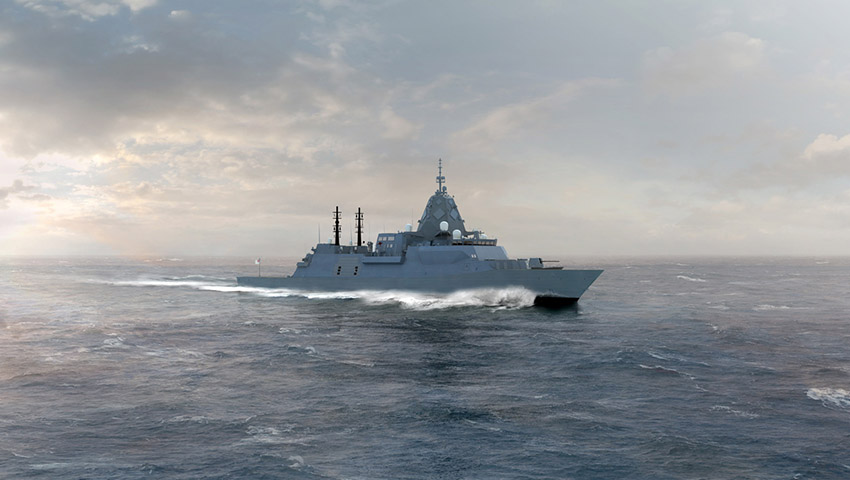It seems as though the Royal Australian Navy’s big-ticket acquisition projects can’t seem to catch a break with concerns about the $35 billion SEA 5000 Hunter Class frigate program now coming to the surface, however, how accurate are the concerns?
To continue reading the rest of this article, please log in.
Create free account to get unlimited news articles and more!
When the Commonwealth announced in June 2018, it would be partnering with BAE Systems Australia as the successful tender for the $35 billion SEA 5000 Future Frigate program, it seemed as if the pieces were finally falling into place for the government's signature $95 billion naval shipbuilding plan.
Despite the well documented challenges facing the Future Submarine Program, the Hunter Class appears to have be progressing well, at least until now, with Andrew Tillet of The Australian Financial Review reporting on a series of concerns stemming from within industry and Defence in an article titled 'Sinking feeling: Frigate heads back to drawing board'.
In this piece, Tillet quoting the Department of Defence confirmed that the dimensions of the Hunter Class frigates have grown as part of the design phase in order to accommodate Australian specific requirements, ranging from radars and computers, through to the American-designed Aegis combat system.
Tillet stated, "BAE Systems conceded the frigate may have to swell in size but insisted it would still meet the Navy's requirements.
"The Australian Financial Review understands senior naval officers are beginning to have misgivings, although the relationship is nowhere near as strained as it is with the French submarine designer Naval Group."
Tillet added, "The initial design, as pitched to the government, gave the frigate a weight of 8800 tonnes when fully loaded and length of 149.9 metres.
"The winning bid deviated from the base UK design because it was required to include the Australian developed CEA phased array radar, the American Aegis combat system and an Australian developed combat tactical interface by SAAB."
This recognition appears to make a mountain out of a molehill, at a time when concerns about the value for money proposition presented by major defence acquisition program is increasingly in the spotlight.
Adding to his concerns, Tillet quoted an 'industry source', who said: "One industry source said the frigate's weight was on track to exceed 10,000 tonnes, necessitating the need for the hull to become bigger, which could affect its speed, acoustic performance and ability to conduct stealthy anti-submarine warfare operations.
"A larger vessel has several flow-on costs, including construction, needing extra fuel for sailing and the provision of wharf infrastructure."
Craig Lockhart, managing director of BAE subsidiary ASC Shipbuilding, countered the concerns raised by both Tillet and the unnamed industry source, telling Defence Connect, "ASC Shipbuilding is currently going through the normal naval design process for the Hunter Class frigate and is working collaboratively with the Capability Acquisition and Sustainment Group and the Royal Australian Navy to design a ship that meets Australia’s capability and performance requirements.
"This design work involves understanding the impact of the Australian-specific systems and equipment, and incorporating the agreed design activities which have occurred as the first of class Type 26 Global Combat Ship design matures. Contrary to the suggestion made in the article (AFR 26 June 2020), Hunter is not being redesigned, but instead our team is right in the middle of a normal naval ship design process for Hunter."
Building on these points, Lockhart added, "Importantly, the design activities being undertaken remain within the agreed weight and space envelopes for Hunter and we remain confident in our ability to meet the capability requirements and specifications for the Commonwealth, on time and on budget.
"The Hunter Class Frigate Program is on target to cut steel for prototyping in December 2020 and for first of class construction in December 2022."
Australia's nine Hunter Class frigates will be based on the BAE Systems Type 26 Global Combat Ship currently under construction for the Royal Navy and will replace the eight Anzac Class frigates when they enter service beginning in the late 2020s.
The Hunter Class is billed as an anti-submarine warfare (ASW) centric vessel delivering an advanced ASW capability to the Royal Australian Navy at a time when 50 per cent of the world’s submarines will be operating in the Indo-Pacific region.
BAE Systems Australia announced that it had selected Lockheed Martin Australia and Saab Australia as combat systems integration industry partners, responsible for delivering the Australian designed CEAFAR 2 Active Phased Array Radar, Lockheed Martin designed Aegis combat management system and Saab Australia 9LV tactical interface.
The $35 billion program sees ASC Shipbuilding become a subsidiary of BAE Systems throughout the build process beginning in 2020 at the Osborne Shipyard in South Australia, creating more than 4,000 jobs.
BAE Systems expects the Australian industry content (AIC) for the Hunter Class build will be 65-70 per cent, which will create and secure thousands of jobs for decades.
At the end of the program the Commonwealth will resume complete ownership of ASC Shipbuilding, thereby ensuring the retention in Australia of intellectual property, a highly skilled workforce and the associated equipment.
SEA 5000 is expected to support over 500 Australian businesses who have been pre-qualified to be part of the Hunter Class supply chain, with the Australian steel industry in particular, benefiting from the 48,000 tonnes of steel required to build the ships.
Stephen Kuper
Steve has an extensive career across government, defence industry and advocacy, having previously worked for cabinet ministers at both Federal and State levels.

 Login
Login








